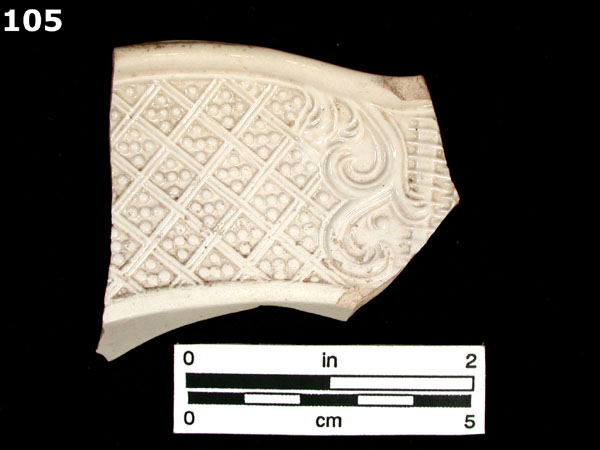Mira todos los ejemplos de STONEWARE, WHITE SALT GLAZED

| Nombre Tipológico: | STONEWARE, WHITE SALT GLAZED |
| Índice del Tipo: | STONEWARE |
| Lugar de Producción: | ENGLAND |
| Fecha de Producción: | 1720-1770 |
| Definir Atributos: |
Thin, light grey or white, vitreous, dense stoneware paste. Salt-glazed surface, producing a glossy, white fine “orange peel” finish. When decorated, techniques include press molding, slip casting, engine turning, and incising. These were sometimes combined with overglaze painting and transfer printed designs. Early examples (before 1720) have grayer paste and are dipped into a thin white slip before firing, producing a slight division between glaze and body, and a diminution in orange peel finish. Dipped mugs often have a brown rim edge. After ca. 1740, molded plate rims in standardized patterns were introduced. Motifs include "dot, diaper and basket" (specimen #’s 100, 103, 105, 107-109) , "bead and reel"(#’s 101, 111), and "barley" (#’s 102,113,114). |
| Forma del Recipiente: |
CUP PLATE PLATTER TEA POT |
| Comentarios: | Although early, brown edged dipped white salt-glazed pieces stayed in production through much of the 18th century. Molded plate rim motifs after 1740 included "dot, diaper and basket" (specimen #’s 100, 103, 105, 107-109), "bead and reel"(#’s 101, 111), and "barley" (#’s 102,113,114). White salt-glazed stoneware tablewares were gradually superceded by refined earthenwares after ca. 1760. |
| Definiciones Publicadas: | http://www.jefpat.org/diagnostic/Historic_Ceramic_Web_Page/Historic_Main.htm; Noel Hume 1970, 2001 |